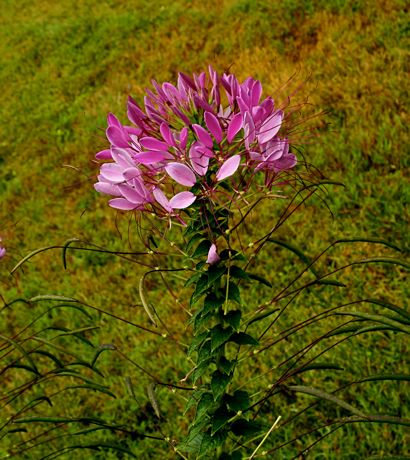Eric’s Pet Plant: Spider Flower (Cleome hassleriana)
Eric doesn’t know this (or didn’t, when he sent this column) but cleomes and I have a long history. My mother always had a good sized stand of them in a bed beside the lawn, and when I was a tot they sort of scared me. The bushy plants were way bigger than I was. The flower stems did seem kind of spidery, and they had hidden prickles that made grabbing unwise. One way and another I failed to see the beauty part.

The spider epithet comes from the seedpods, which continue to develop as the main stalk continues to flower. ” Looks great in a large vase!” says Eric. I agree.
Later, when I started growing lots of annuals, cleomes didn’t make the cut. Don’t know why. Possibly because of that early trauma, possibly because they went through a period of being unfashionable – in addition to the prickles they have the same sticky quality as petunias and nicotianas, and the slight but musky fragance is not to everyone’s taste.
But now I grow them almost every year, usually between the peonies and the garden fence. As usual, my mother was right: a mass of them is truly striking, whether in the garden or the vase; they seldom get bugs or diseases; they don’t need much fertilizer or – once established – supplementary watering. And being very nearly weeds themselves, they take no guff from weeds.
Spider Flower (Cleome hassleriana)
By Eric Larson
A few years ago, I took a big bouquet of Iris to a party at the President’s House here at Yale. I got an email the next day, thanking me for the contribution, and without realizing what I was starting, I suggested that we could grow a number of Iris varieties specifically for display at 47 Hillhouse around commencement and alumni weekends.
The iris have been greeted with such enthusiasm that I doubled down this year. We designed and planted a cutting garden, partly as an exercise, partially for display and also to provide provender for the vases of our friends in high places.
We restricted the plant selection to annuals, as I didn’t want to commit that space to a permanent installation. But there is a large assortment, among them a good stand of cleomes.

I love Cleome. I am fond of big plants and this one is a joy to watch grow. I love the way the flowers start when the plant is half grown and the fact that they continue to grow “up the stem” as the plant continues to develop.
GROWING CLEOME
Cleome is a wonderful flower for cutting and (before it blooms) an interesting cannabis-impersonator. And the fact that it’s borderline invasive if allowed to set seed is a great incentive to keep making bouquets.
I have done some research on the etymology of the name, and although I’m not sure what this refers to on the plant, the best I have come up with is that it comes from the Greek kleio, meaning ‘to enclose’ [some sources say it’s the Greek kleos, roughly meaning ‘glory’ LL]. There are a number of species native to the continental United States, but today’s plant comes from South America, specifically southeastern Brazil, Paraguay, Uruguay and Argentina.

Here in the ‘Neutral Corner’ of our boxing match, I mean cut flower garden, the white Cleome and the Feather Celosia dominate, with a few odds and ends mixed in.
Cleome is an annual that can grow as much as six or seven feet tall with a spread of three to four. In rich soil or on windy sites, it should be staked to keep it from lodging, or falling over. It prefers full sun, sandy to loamy well-drained soil that is not too rich and moderate moisture. Although not particularly drought tolerant, it will revive from dry conditions more quickly than other flowers.
Cleome grows quickly and can be direct sown after the weather warms, but I get earlier flowers by starting the seeds indoors about four weeks before last frost date. It doesn’t help to start earlier than that because the seedlings will get too leggy in the pot and be set back in the long run. If falling over seems likely, stake it as it grows. No matter what else you do, cut the flowers and dead head assiduously lest you be visited next year by the goddess Cleome and her many minions. They do re-seed with alacrity.
The color range is white to pink to purple, with mauve, periwinkle and violet mixed in. Cut the flowers in early morning when the dew is still on the plant. Remove the lower leaves, taking care of your hands – the stems have spines that bite. To increase vase life, immediately immerse the stems in tepid water right up to the neck and leave them there for an hour or two.
Even with this treatment they only last a few days, but for the right setting, there is nothing like a huge vase filled with stately cleome, flowers on top, spidery seed pods dangling to the sides.

Cleome has a sort of musky fragrance, not wholly unpleasant but more vegetal than floral. And the leaves really do look like a variety of cannabis, so care must be taken to place them far away from your medical marijuana patch.
















Get a Trackback link